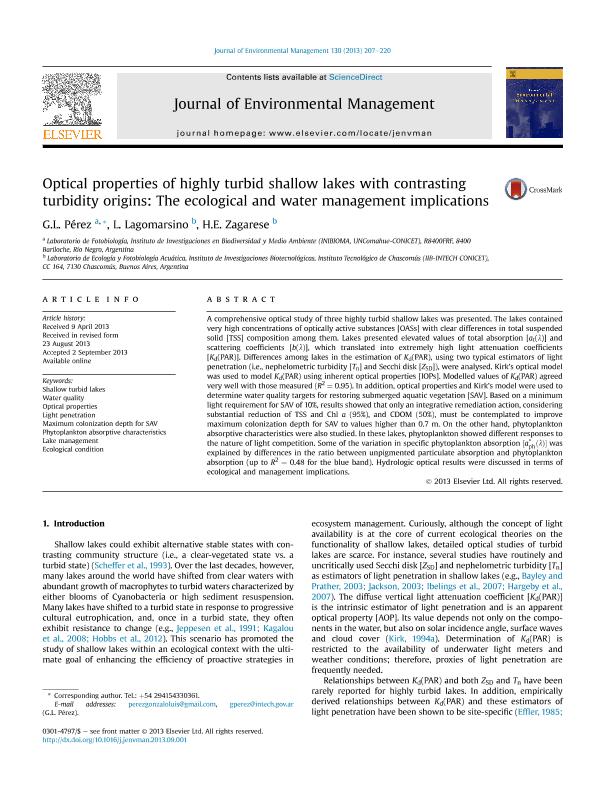Artículo
Optical properties of highly turbid shallow lakes with contrasting turbidity origins: The ecological and water management implications
Fecha de publicación:
30/11/2013
Editorial:
Academic Press Ltd-elsevier Science Ltd
Revista:
Journal of Environmental Management
ISSN:
0301-4797
e-ISSN:
1095-8630
Idioma:
Inglés
Tipo de recurso:
Artículo publicado
Clasificación temática:
Resumen
A comprehensive optical study of three highly turbid shallow lakes was presented. The lakes contained very high concentrations of optically active substances [OASs] with clear differences in total suspended solid [TSS] composition among them. Lakes presented elevated values of total absorption [at()] and scattering coefficients [b()], which translated into extremely high light attenuation coefficients [Kd(PAR)]. Differences among lakes in the estimation of Kd(PAR), using two typical estimators of light penetration (i.e., nephelometric turbidity [Tn] and Secchi disk [ZSD]), were analysed. Kirk´s optical model was used to model Kd(PAR) using inherent optical properties [IOPs]. Modelled values of Kd(PAR) agreed very well with those measured (R2 = 0.95). In addition, optical properties and Kirk´s model were used to determine water quality targets for restoring submerged aquatic vegetation [SAV]. Based on a minimum light requirement for SAV of 10%, results showed that only an integrative remediation action, considering substantial reduction of TSS and Chl a (95%), and CDOM (50%), must be contemplated to improve maximum colonization depth for SAV to values higher than 0.7 m. On the other hand, phytoplankton absorptive characteristics were also studied. In these lakes, phytoplankton showed different responses to the nature of light competition. Some of the variation in specific phytoplankton absorption [a*ph()] was explained by differences in the ratio between unpigmented particulate absorption and phytoplankton absorption (up to R2 = 0.48 for the blue band). Hydrologic optical results were discussed in terms of ecological and management implications.
Archivos asociados
Licencia
Identificadores
Colecciones
Articulos(CCT - LA PLATA)
Articulos de CTRO.CIENTIFICO TECNOL.CONICET - LA PLATA
Articulos de CTRO.CIENTIFICO TECNOL.CONICET - LA PLATA
Articulos(IIB-INTECH)
Articulos de INST.DE INVEST.BIOTECNOLOGICAS - INSTITUTO TECNOLOGICO CHASCOMUS
Articulos de INST.DE INVEST.BIOTECNOLOGICAS - INSTITUTO TECNOLOGICO CHASCOMUS
Citación
Pérez, Gonzalo; Lagomarsino, Leonardo; Zagarese, Horacio Ernesto; Optical properties of highly turbid shallow lakes with contrasting turbidity origins: The ecological and water management implications; Academic Press Ltd-elsevier Science Ltd; Journal of Environmental Management; 130; 30-11-2013; 207-220
Compartir
Altmétricas




